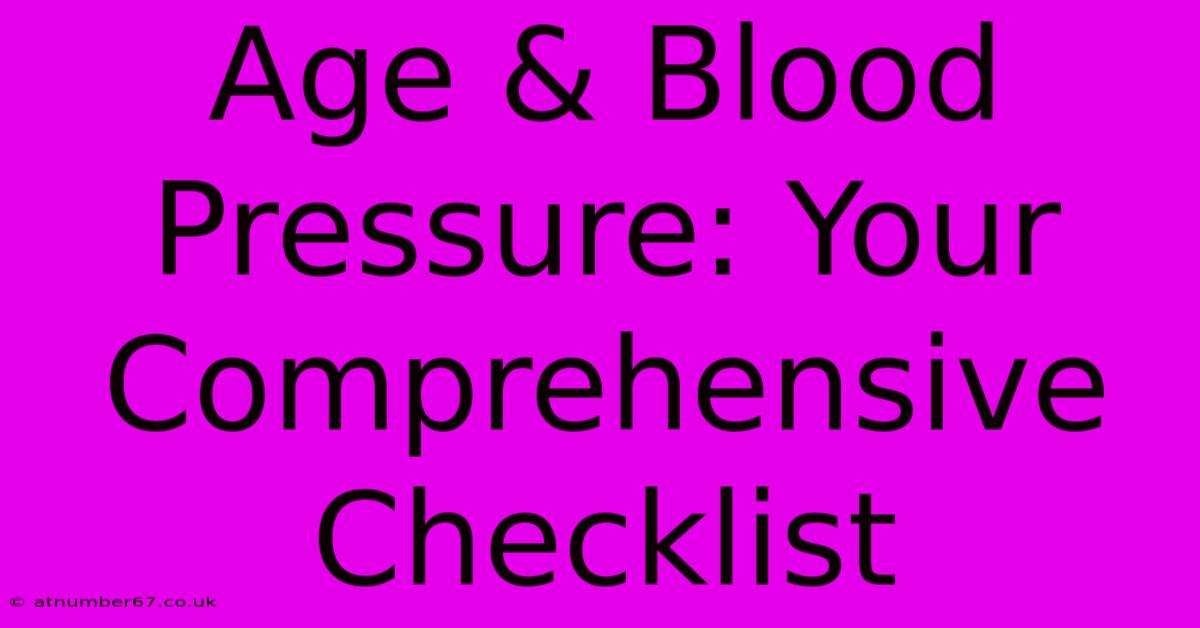Age & Blood Pressure: Your Comprehensive Checklist

Table of Contents
Age & Blood Pressure: Your Comprehensive Checklist
Understanding the relationship between age and blood pressure is crucial for maintaining your overall health. As we age, our risk for hypertension (high blood pressure) increases significantly. This comprehensive checklist will help you understand the connection, identify potential risks, and take proactive steps to manage your blood pressure at every stage of life.
Understanding the Age-Blood Pressure Connection
Blood pressure, the force of blood against your artery walls, naturally fluctuates throughout life. However, the likelihood of developing high blood pressure increases substantially with age. Several factors contribute to this:
- Stiffening Arteries: As we age, our arteries lose elasticity, making it harder for blood to flow smoothly. This increased resistance leads to higher blood pressure.
- Reduced Kidney Function: The kidneys play a vital role in regulating blood pressure. As kidney function declines with age, the body's ability to control blood pressure diminishes.
- Hormonal Changes: Hormonal shifts associated with aging, such as menopause in women, can impact blood pressure regulation.
- Increased Prevalence of Underlying Conditions: Chronic conditions like diabetes and heart disease, which become more common with age, often contribute to hypertension.
Blood Pressure Checklists by Age Group
While individual variations exist, general guidelines for blood pressure monitoring vary based on age. Here's a breakdown:
Young Adults (18-39):
- Baseline Check: Schedule a blood pressure check with your doctor during a routine physical. This establishes a baseline for future comparisons.
- Lifestyle Factors: Focus on healthy habits – maintaining a balanced diet, regular exercise, and avoiding smoking and excessive alcohol consumption.
- Monitoring: If you have a family history of hypertension or other risk factors, more frequent monitoring may be advised.
Middle-Aged Adults (40-64):
- Regular Checkups: Get your blood pressure checked at least once a year, or more frequently if recommended by your physician.
- Risk Assessment: Discuss your risk factors (family history, weight, diet, activity level) with your doctor.
- Lifestyle Modifications: Make necessary adjustments to your lifestyle to address any identified risk factors. This may involve diet changes, increased physical activity, or stress management techniques.
Older Adults (65+):
- Frequent Monitoring: Blood pressure should be checked more regularly, potentially every 3-6 months, or as advised by your healthcare provider.
- Medication Management: Many older adults require medication to manage hypertension. Regular monitoring and medication adjustments are crucial.
- Potential Side Effects: Be aware of potential side effects of blood pressure medication and discuss any concerns with your doctor. Older adults are more susceptible to medication interactions.
Warning Signs & When to Seek Medical Attention
Don't ignore potentially concerning symptoms. Seek immediate medical attention if you experience:
- Severe headache: A sudden, intense headache could be a sign of a hypertensive crisis.
- Shortness of breath: Difficulty breathing can be a symptom of high blood pressure affecting the heart and lungs.
- Nosebleeds: Frequent or unusually heavy nosebleeds can indicate high blood pressure.
- Dizziness or lightheadedness: These sensations may signal low blood pressure, but can also be related to high blood pressure complications.
- Chest pain: Chest pain or discomfort should always be evaluated by a medical professional.
Proactive Steps to Manage Your Blood Pressure
Regardless of your age, these steps can significantly impact your blood pressure:
- Maintain a Healthy Diet: Focus on fruits, vegetables, whole grains, and lean proteins. Limit sodium intake.
- Regular Exercise: Aim for at least 150 minutes of moderate-intensity aerobic activity per week.
- Manage Stress: Practice relaxation techniques like yoga or meditation.
- Limit Alcohol Consumption: Excessive alcohol can raise blood pressure.
- Quit Smoking: Smoking damages blood vessels and increases blood pressure.
- Maintain a Healthy Weight: Obesity is a significant risk factor for hypertension.
Conclusion
Age is a significant factor in blood pressure management. By understanding the age-related changes and taking proactive steps, you can significantly reduce your risk of developing hypertension and its associated complications. Regular checkups, lifestyle modifications, and open communication with your doctor are key to maintaining healthy blood pressure throughout your life. Remember, early detection and intervention are crucial for preventing serious health problems.

Thank you for visiting our website wich cover about Age & Blood Pressure: Your Comprehensive Checklist. We hope the information provided has been useful to you. Feel free to contact us if you have any questions or need further assistance. See you next time and dont miss to bookmark.
Featured Posts
-
Gyanendra Shah A Kings Struggle For Power
Apr 06, 2025
-
Mark Cuban Net Worth How To Make Smart Investments
Apr 06, 2025
-
Janhvi Kapoor A Bollywood Success Story
Apr 06, 2025
-
Badshah Age The Power Of Experience
Apr 06, 2025
-
What Lattos Mom Wants You To Know
Apr 06, 2025
